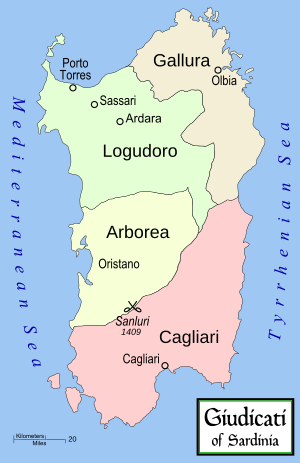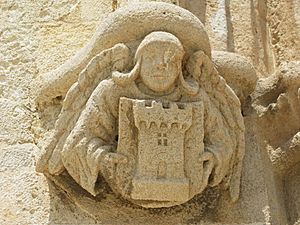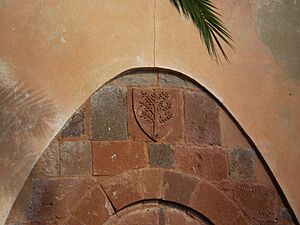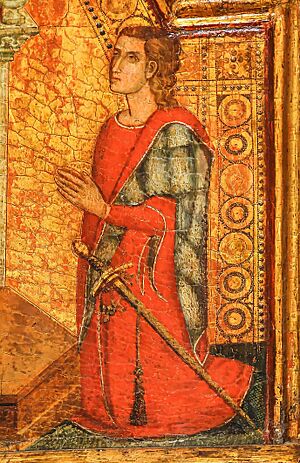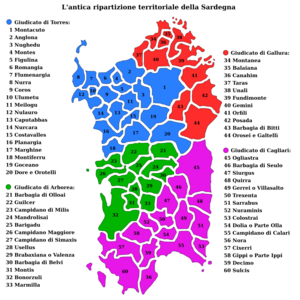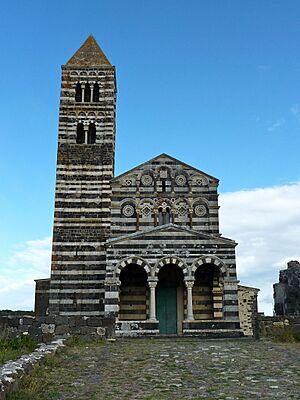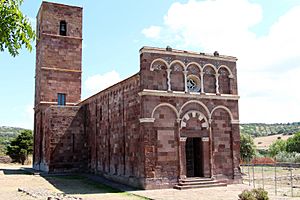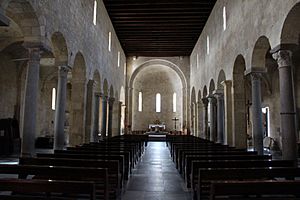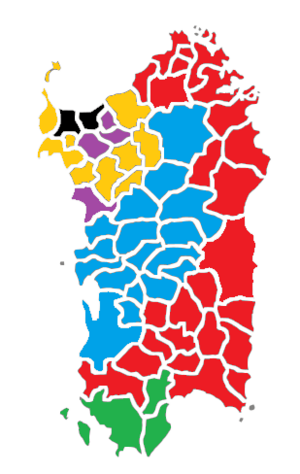Sardinian medieval kingdoms facts for kids
The Judicates were independent states in Sardinia during the Middle Ages. They existed from the 9th to the 15th century. These states were like small kingdoms. Each one had a ruler called a judge (judike in Sardinian). These judges had the same powers as a king.
Contents
How the Kingdoms Started
Sardinia was part of the Byzantine Empire from 535 AD. This was after a short time under the Vandals.
After 705 AD, Saracen pirates from North Africa began attacking the island. The Byzantine army did not stop them well. In 815, Sardinians asked for help from the Carolingian Emperor.
The Arabs tried to invade Sardinia several times. But the Sardinians fought them off. In 851, Pope Leo IV even asked the judge of Sardinia for help. He wanted help to defend Rome. Sardinia became separate from the Byzantine Empire. It had to become independent in its economy and military.
The Four Kingdoms Begin
We don't know exactly when Sardinia changed from Byzantine rule to self-rule. It is thought that the main judge of Sardinia, based in Caralis, had full control. He appointed family members as local leaders. These leaders became very independent over time. This likely led to the start of the kingdoms.
The first clear proof of four kingdoms is a letter from Pope Gregory VII. He sent it in 1073 to the Sardinian judges. These judges were from Cagliari, Arborea, Torres, and Gallura. But they were already called "princes of Sardinia" in a letter from Pope John VIII in 872.
The four main medieval Judicates were:
- Kingdom of Cagliari with its capital in Santa Igia.
- Kingdom of Arborea with its capital in Oristano.
- Kingdom of Gallura with its capital in Civita.
- Kingdom of Torres with its capital in Porto Torres, Ardara, and later Sassari.
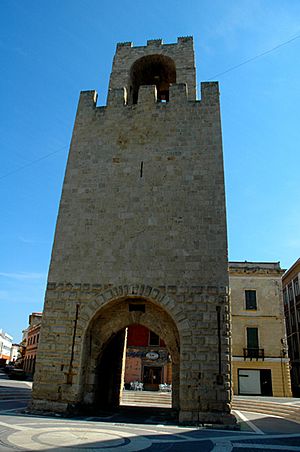
Each of these states had strong borders. They protected their trade and political interests. They also had their own laws, government, and symbols.
How the Governments Worked
The way the Judicates were run was different from other parts of medieval Europe. Their systems were more like those in the Byzantine Empire. But they also had their own unique Sardinian ways.
The Judicates had semi-democratic systems. For example, they had councils called Coronas de curatorias. These councils chose people to represent them in a bigger parliament. This parliament was called the Corona de Logu.
The Corona de Logu and the Main Council
The judge was the main ruler of the Judicate. But he did not own all the land. The power belonged to the Corona de Logu. This was a council of elders and important priests. They chose the ruler and gave him power. They also had the power to approve laws and agreements for the whole kingdom.
During the coronation, people from different areas gathered. These included high priests and castle lords. The judge was crowned using a mix of election and family inheritance. The title usually passed down through the male line. If there were no male heirs, it could pass through the female line.
The judge ruled based on an agreement with the people. This was called the bannus-consensus. If a ruler was unfair, the people could remove him. They could even execute him. This would not stop the family from keeping the title.
The Judges
The judge was not an absolute ruler. He could not declare war or sign peace treaties alone. He needed the approval of the Corona de Logu. However, this council was often made up of the ruler's relatives. So, they usually shared the same interests.
The throne was usually passed down through the family. But sometimes, the Corona De Logu could choose a new ruler.
The Judge's Office
The judge had help from an office called the Chancellery. Official papers were written there. These papers were called bullata paper. The main writer was the state chancellor. This was usually a bishop or a high-ranking priest. Other officials helped him.
Local Administration
Curadorias
The kingdoms were divided into areas called curadorias. These were administrative districts. They included towns and villages. Each curadoria had a capital city. A curadore was in charge of this area. They were helped by judges and a local council. They managed local justice and public property.
The curadore appointed a majore de Bidda for each village. This was like a modern mayor. They had powers over administration and justice. They were also responsible for managing land.
Laws and Rules
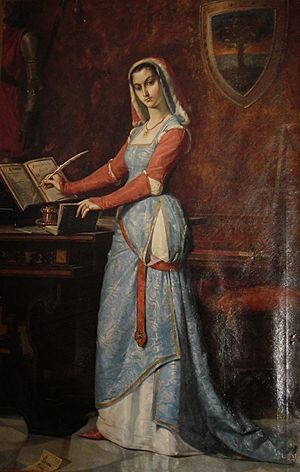
The Cartas de Logu were important collections of laws. They covered criminal, public, civil, and land rules. Sadly, only parts of the Carta Caralitana have survived. The Carta de Logu of the Kingdom of Arborea was very important. It was created by Mariano IV and later by his daughter Eleonora. She updated the laws to fit new social conditions. The Chart was written in Sardinian. This made sure that citizens could understand the laws. They knew what was allowed and what was not. This created a clear legal system.
The Chart stayed in use for a long time. It was used even after the Judicate period. It remained law until 1827. The Chart shows that the Judicates cared about protecting the countryside. They also protected farming, horse breeding, and leather production. This helped them fight for Sardinia's independence.
The Condaghes are also very important. They help us study the period between the 11th and 13th centuries. A condaghe was a register. It recorded gifts to monasteries or churches. These records detailed money, servants, lands, vineyards, and livestock. From the Condaghes, we can learn a lot about the Judicates. They are also the oldest examples of the ancient Sardinian language.
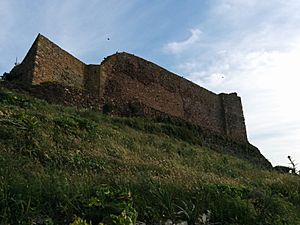
The Judicial Army
The Sardinian armies were made up of soldiers and free citizens. They served for a certain time. In emergencies, people were forced to join. The best soldiers were called bujakesos. They were chosen riders. They served under the janna de Majore, who was the ruler's security chief. Their main weapons were swords, chain mail, shields, and helmets. They also used the birrudu, a weapon like a Roman javelin.
Foot soldiers used a shorter version of this weapon. They also used spears and shields. Another common weapon was the leppa. This was a sword with a bone handle and a curved blade. It was about 50 to 70 cm long. It was used until the late 1800s. Sardinians also made a type of longbow. Later, the crossbow became popular.
Judges often hired soldiers from other places. For example, they used skilled Genoese crossbowmen.
Culture and Life
Religion
Christianity spread across most of Sardinia early on. But parts of the Barbagia region were not Christian. In the late 6th century, Pope Gregory I made a deal with a local chief. This helped convert his people from paganism to Christianity. Sardinia was part of the Byzantine Empire. So, it developed some Greek and Eastern Christianity traditions. This was due to monks from the East.
The Sardinian Church was independent for 500 years. It was separate from both the Byzantine and Roman churches. In the 11th century, the judges started to bring Western monks to the island. They wanted to spread culture and new farming methods. Monks came to the island with money from donations. Local churches were built by the noble families. But there were still strong ties to Eastern traditions. In 1092, the Pope officially ended the Sardinian Church's independence. It was then placed under the Archbishop of Pisa.
The first donation was in 1064. Barisone I of Torres gave land and churches to Benedictine monks. Many religious groups came to Sardinia after that. This led to a boom in Romanesque architecture on the island.
Language
During the Byzantine period, Byzantine Greek was used for official business. But it stopped being used. Vulgar Latin, which was the language of the local people, changed over time. It became the Sardinian language. This became the official language. It was used in legal papers and laws, like the condaghe and the Carta de Logu.
The End of the Kingdoms
Pisa and Genoa started to get involved in Sardinia in the 11th century. They helped the Judicates fight against a Muslim kingdom that wanted to conquer the island.
By the late 13th century, the kingdoms of Logudoro, Gallura, and Cagliari lost their independence. Genoa and Pisa used their power over trade and churches to gain control. The Kingdom of Logudoro ended in 1259. Its lands were taken over by the Genoese families Doria and Malaspina. Cagliari was conquered in 1258 by an alliance of Pisa and Sardinia. Its land was split among the winners. Gallura went to the Visconti family and then to Pisa in 1288.
Arborea lasted longer. From 1323 to 1326, it joined with the Crown of Aragon. They conquered Pisa's lands in Sardinia. But the Aragonese wanted to control the whole island. So, in 1353, the Kingdom of Arborea, led by Marianus IV of Arborea, broke its alliance. It declared war against the Aragonese. In 1368, Arborea almost drove the Aragonese out of the island. Only the port cities of Cagliari and Alghero remained under Aragonese control. A peace treaty in 1388 gave the Aragonese their lands back. But problems continued. In 1391, the Arborean army, led by Brancaleone Doria, took most of the island again.
This lasted until 1409. The Arborean army was badly defeated by the Aragonese in the Battle of Sanluri.
The Kingdom of Arborea ended in 1420. The last judge, William II of Narbonne, sold its lands to the Aragonese for 100,000 gold coins.
See also
 In Spanish: Juzgados sardos para niños
In Spanish: Juzgados sardos para niños
- Castles of Sardinia


